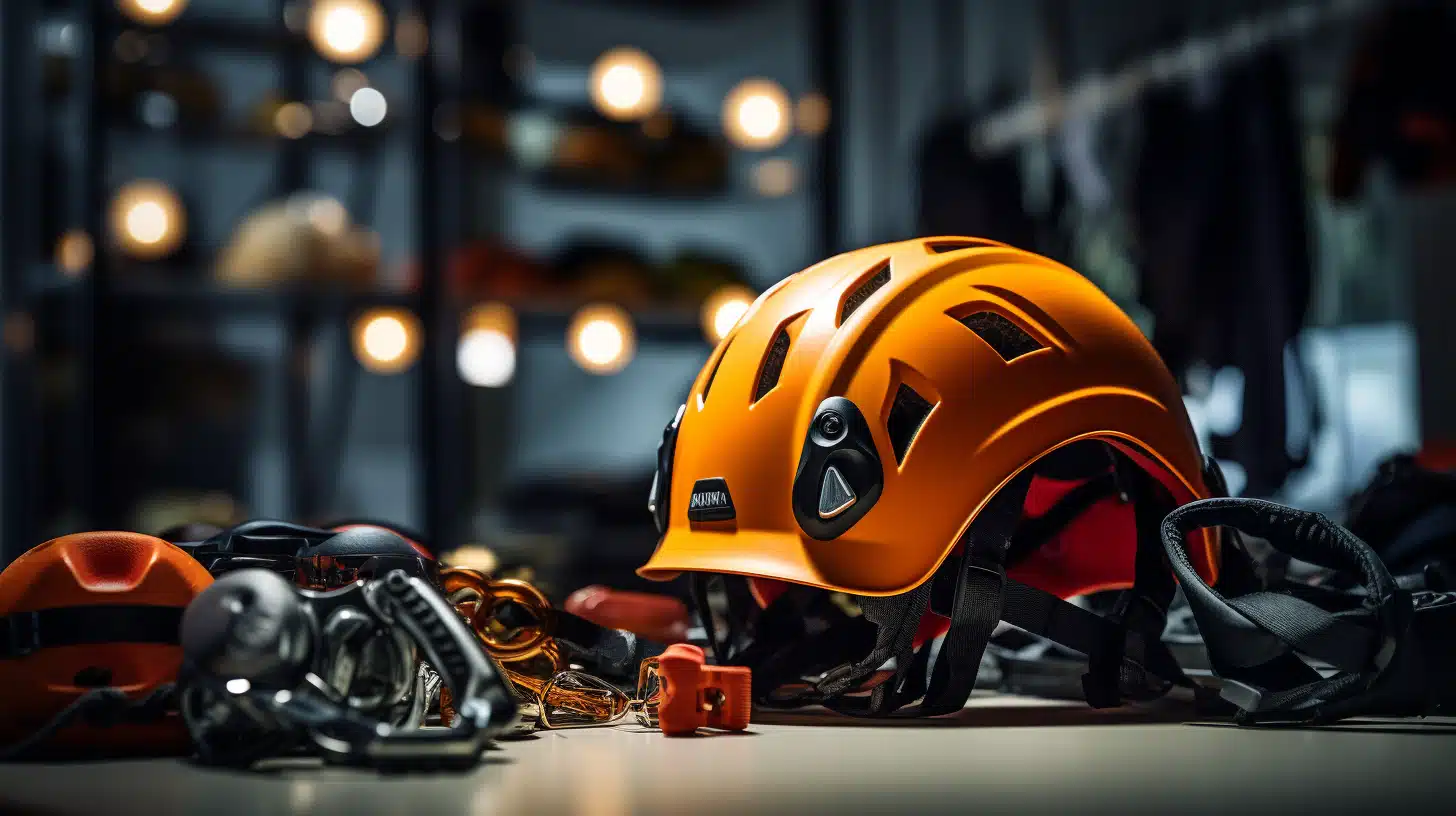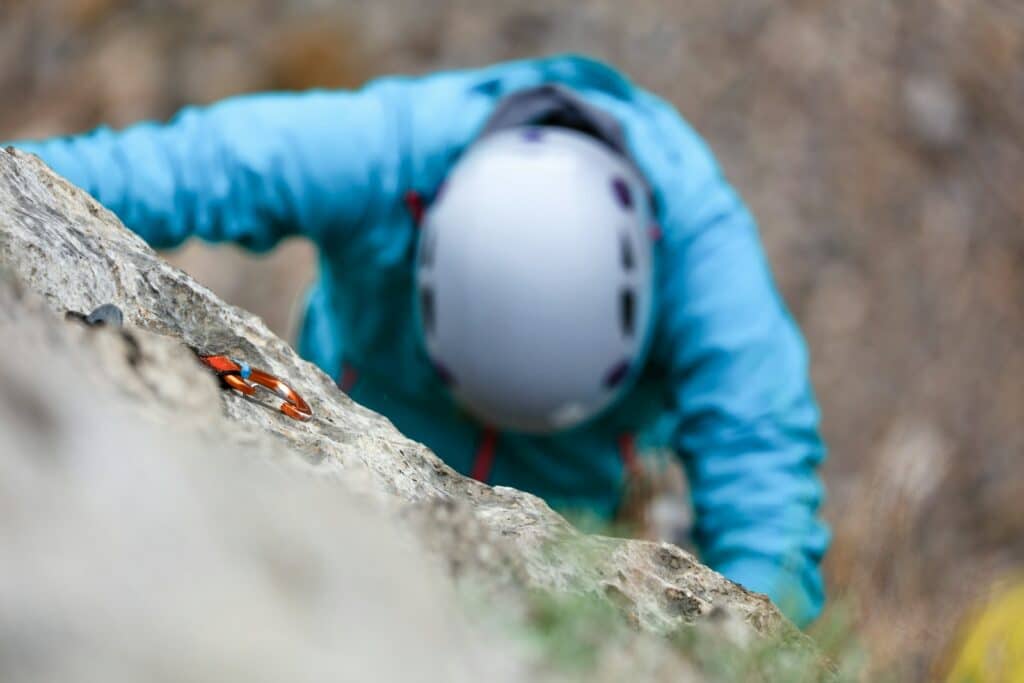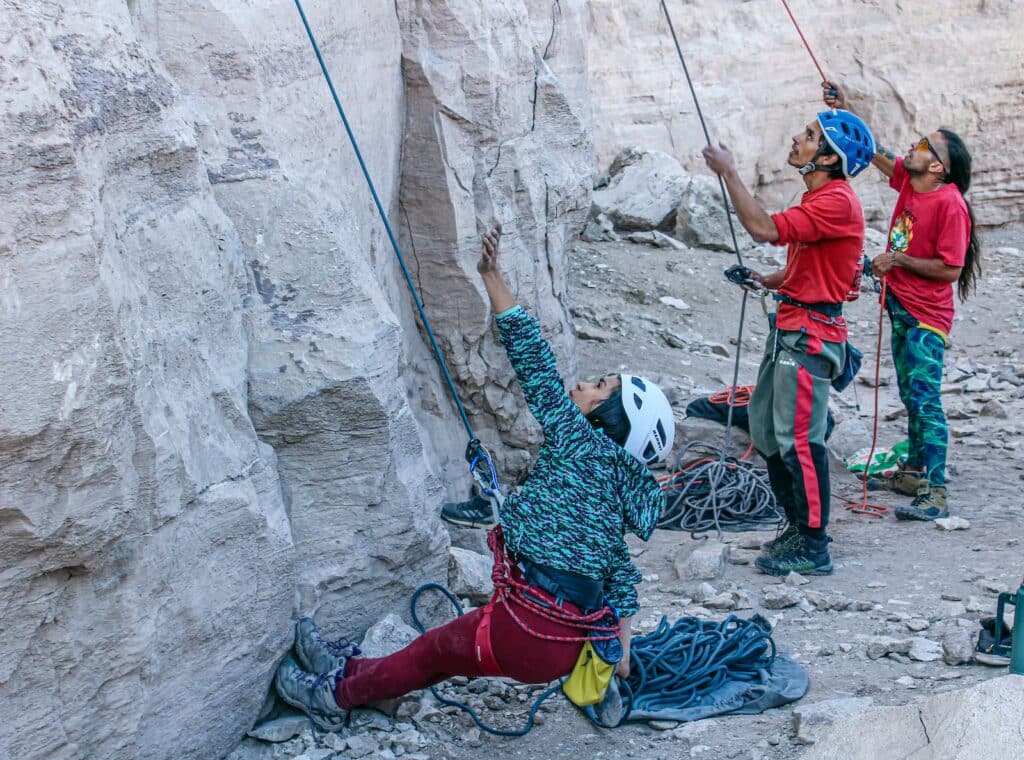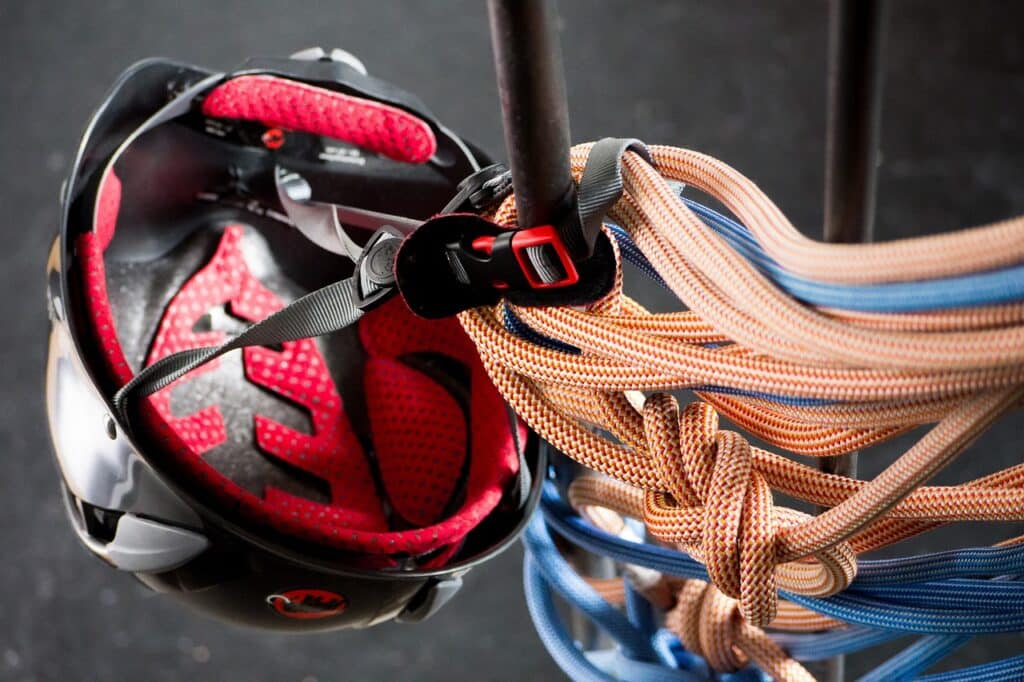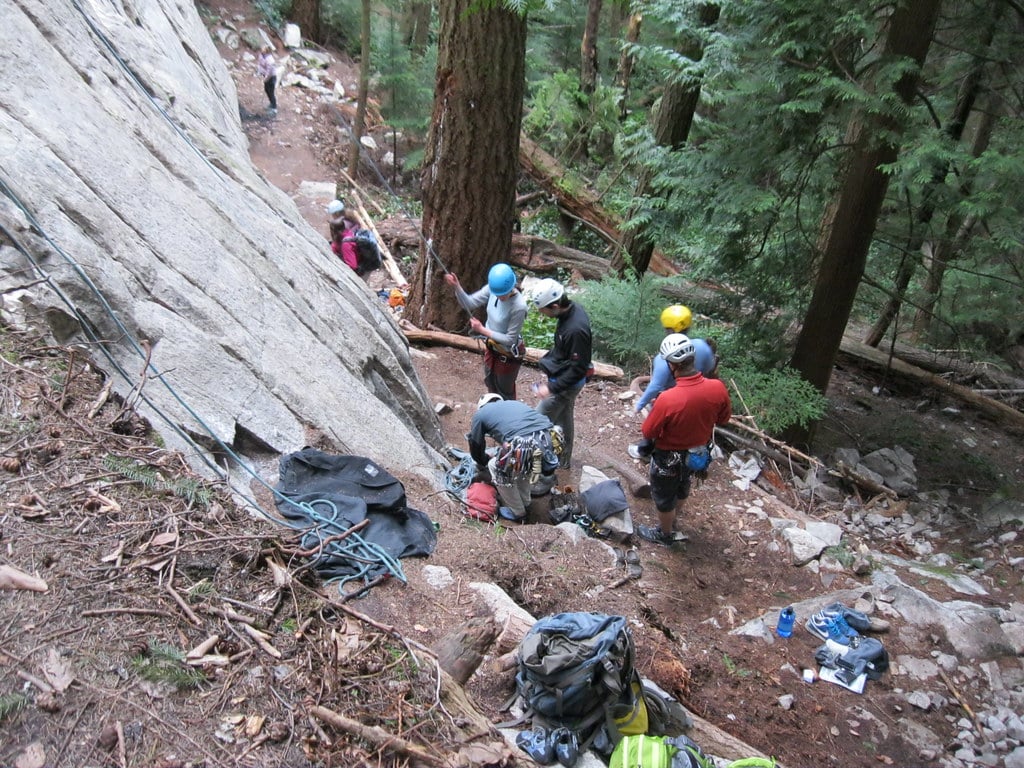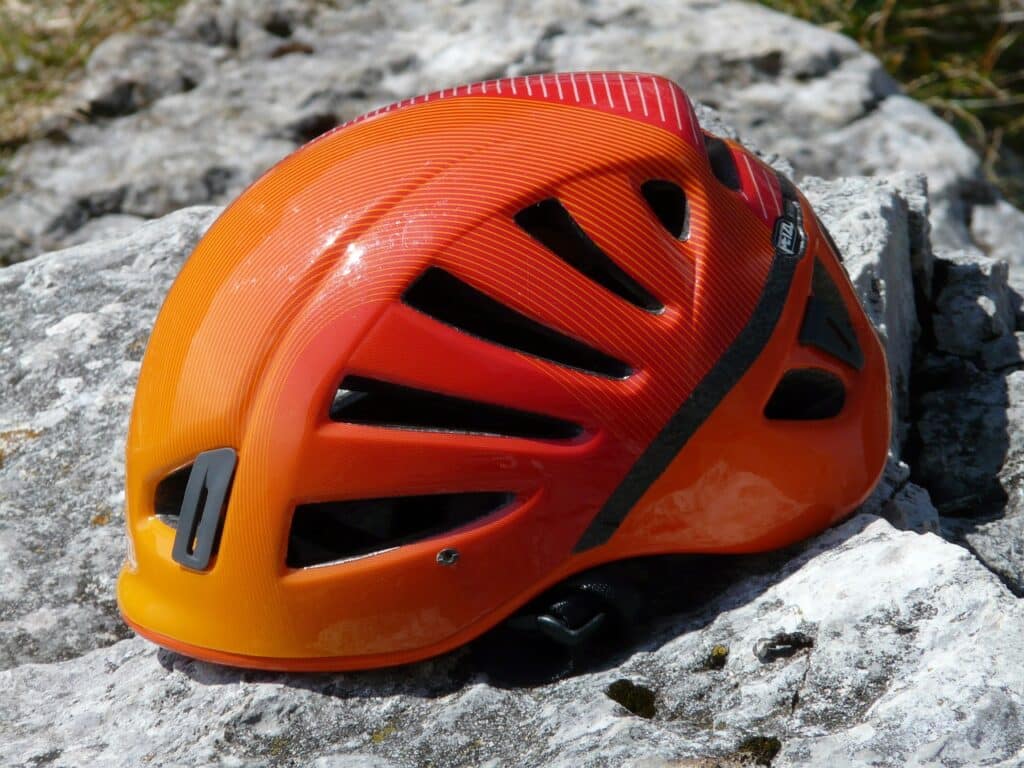Table of Contents
ToggleTrad Climbing Helmets: An Essential Piece of Gear
When it comes to trad climbing, ensuring your safety is paramount, and one essential piece of gear that should never be overlooked is a trad climbing helmet. Trad climbing helmets are specifically designed to protect your head from falling objects, impacts with rock or other climbers, and provide protection in the event of a fall (UIAA). Let’s explore the importance of trad climbing helmets and the key features that make them an indispensable part of your climbing gear.
Importance of Trad Climbing Helmets
In the vertical world of trad climbing, there are inherent risks associated with climbing on natural rock formations. The potential for loose rocks, falling debris, or accidental impacts cannot be ignored. A trad climbing helmet acts as your first line of defense, shielding your head from potential hazards. It helps to minimize the risk of head injuries and provides vital protection in case of unexpected incidents.
Wearing a trad climbing helmet is not just a personal choice; it’s a responsible choice. It not only safeguards your own well-being but also sets an example for other climbers, promoting a culture of safety and awareness within the climbing community. Remember, accidents can happen to even the most experienced climbers, making a trad climbing helmet an essential piece of gear for climbers of all skill levels.
Key Features of Trad Climbing Helmets
Trad climbing helmets are designed with specific features to provide optimal protection and comfort during your climbing adventures. Some key features to consider when choosing a trad climbing helmet include:
- Helmet Construction and Materials: The shell of a trad climbing helmet is typically made of a strong, impact-resistant material such as polycarbonate or ABS, providing excellent durability and protection against impacts (UIAA). The liner of the helmet is often composed of shock-absorbing materials like expanded polystyrene (EPS), which effectively absorbs and disperses the force of impacts.
- Helmet Fit and Adjustability: A proper fit is crucial for the effective functioning of a trad climbing helmet. Look for helmets with adjustable features that allow you to customize the fit to your head shape and size. An adjustable chin strap ensures a secure and snug fit, preventing the helmet from shifting or falling off during climbs.
- Industry Safety Standards and Certifications: When selecting a trad climbing helmet, it’s essential to choose one that meets industry safety standards and certifications. Look for helmets that comply with standards such as UIAA (International Climbing and Mountaineering Federation) or CE (European Conformity) certification. These certifications ensure that the helmet has undergone rigorous testing and meets specific safety requirements (Petzl).
By understanding the importance of trad climbing helmets and considering the key features, you can make an informed decision when choosing a helmet that suits your needs and provides the necessary protection for your trad climbing adventures. Remember, your safety is in your hands, or in this case, on your head. So, never forget to wear a trusted trad climbing helmet every time you hit the crag.
Choosing the Right Trad Climbing Helmet
When it comes to trad climbing, wearing a helmet is essential for protecting your head from falling objects, impacts with rock or other climbers, and providing protection in the event of a fall. Choosing the right trad climbing helmet involves considering factors such as helmet construction and materials, helmet fit and adjustability, and industry safety standards and certifications.
Helmet Construction and Materials
Trad climbing helmets typically consist of a hard shell exterior and a foam liner for shock absorption. The shell of the helmet should be made of a strong, impact-resistant material, such as polycarbonate or ABS. This ensures that the helmet can withstand the force of falling objects or impacts with the rock. The liner is usually made of a shock-absorbing material, such as expanded polystyrene (EPS), which helps absorb and dissipate the energy from impacts, reducing the risk of head injury (UIAA).
Modern trad climbing helmets are designed to be lightweight without compromising on safety. They utilize advanced materials and construction techniques to provide both impact resistance and comfort. The use of lightweight materials, such as expanded polystyrene foam, helps reduce the overall weight of the helmet, making it more comfortable to wear during long climbing sessions (Petzl).
Helmet Fit and Adjustability
A properly fitting helmet is crucial for maximum protection. Trad climbing helmets should be adjustable to ensure a snug and secure fit. Most helmets feature an adjustable internal suspension system that allows you to customize the fit according to the shape and size of your head. This system typically includes a dial or straps that can be adjusted to achieve the desired fit. It’s important to take the time to properly adjust the helmet to ensure a secure and comfortable fit. A helmet that is too loose or too tight may not provide the necessary protection in the event of an impact.
When trying on a trad climbing helmet, make sure it sits level on your head, covering the top, sides, and back. The helmet should not tilt forward or backward, and the chin strap should be snug without causing discomfort. It’s also important to consider the compatibility of the helmet with other headgear, such as headlamps, to ensure a proper fit (Petzl).
Industry Safety Standards and Certifications
To ensure the quality and safety of a trad climbing helmet, it’s important to choose one that meets industry safety standards and certifications. Look for helmets that have undergone rigorous testing and meet specific safety requirements. The most common certifications to look for are the UIAA (International Climbing and Mountaineering Federation) and CE (European Conformity) certifications. These certifications indicate that the helmet has been tested and meets the necessary safety standards (Petzl).
When selecting a trad climbing helmet, check for the presence of these certifications and ensure that they are up to date. This ensures that the helmet has been designed and tested to provide the necessary protection for trad climbing activities.
By considering the construction and materials, fit and adjustability, and industry safety standards and certifications, you can choose a trad climbing helmet that provides the necessary protection while keeping you comfortable during your climbing adventures. Remember, safety should always be a top priority when engaging in trad climbing or any other climbing activity.
Top Trad Climbing Helmets on the Market
When it comes to trad climbing, having a reliable and protective helmet is essential for your safety. Here are some of the top trad climbing helmets that combine safety, comfort, and durability:
Petzl Sirocco: Lightweight and Innovative
The Petzl Sirocco is renowned for being one of the lightest helmets on the market, weighing only 5.8 ounces (165 grams). Despite its featherlight design, the Sirocco doesn’t compromise on safety. It features a hybrid construction of expanded polypropylene foam and a polycarbonate shell, providing excellent impact protection. The Sirocco’s innovative design includes large ventilation holes for optimal airflow and comfort during hot weather climbs.
Black Diamond Vapor: Lightweight and Durable
Built with a combination of Kevlar and carbon rods, the Black Diamond Vapor helmet is exceptionally lightweight without sacrificing durability. This helmet offers excellent protection against impacts, thanks to its co-molded EPS foam and polycarbonate shell construction. The Vapor’s low-profile design ensures a snug fit, and the suspension system provides easy adjustments for a personalized fit.
Mammut Wall Rider MIPS: Enhanced Protection with MIPS
The Mammut Wall Rider MIPS is equipped with the Multi-directional Impact Protection System (MIPS) technology, which helps reduce rotational forces during an impact. This added layer of protection enhances safety in the event of an angled impact. The Wall Rider MIPS features a hybrid construction of a hard shell and an expanded polypropylene foam liner, providing optimal protection and durability.
Petzl Meteor: Ventilated Design for Comfort
Designed with warm weather climbing in mind, the Petzl Meteor boasts a ventilated design with large ventilation holes. This feature ensures optimal airflow to keep you cool and comfortable during strenuous climbs. The Meteor utilizes a lightweight expanded polystyrene foam liner and a polycarbonate shell to provide reliable impact protection.
Edelrid Salathe: Hybrid Construction for Protection and Comfort
The Edelrid Salathe is a hybrid helmet that combines a hard shell with a foam liner for increased protection and comfort. The hard shell provides excellent impact resistance, while the foam liner offers cushioning and shock absorption. The Salathe features a precise adjustment system for a secure and comfortable fit.
Black Diamond Half Dome: Popular Choice for Durability and Comfort
The Black Diamond Half Dome is a popular choice among climbers for its exceptional durability and comfort. It features a molded EPS foam liner and a durable ABS shell to provide reliable impact protection. The Half Dome’s suspension system allows for quick and easy adjustments, ensuring a secure and personalized fit.
Petzl Boreo: Excellent Protection with Headlamp Compatibility
The Petzl Boreo offers excellent protection with its hybrid construction of expanded polystyrene foam and a durable ABS shell. This helmet is designed to withstand impacts from all angles, providing reliable protection during trad climbing. The Boreo also features a robust headlamp attachment system, allowing you to easily attach a headlamp for nighttime climbs.
Black Diamond Vision MIPS: Premium Helmet with Rotational Impact Protection
The Black Diamond Vision MIPS is a premium helmet designed for maximum protection and comfort. Equipped with MIPS technology, it helps reduce rotational forces during an impact. The Vision MIPS features a lightweight construction with a combination of EPS foam and a durable polycarbonate shell. It offers comprehensive head coverage and boasts excellent ventilation for enhanced comfort.
When choosing a trad climbing helmet, prioritize safety, comfort, and fit. Consider factors such as helmet construction, materials, and industry safety standards. Remember to always inspect your helmet regularly for any signs of damage or wear and replace it if necessary. Investing in a high-quality trad climbing helmet is essential for your protection on the wall.
Differences Between Climbing Helmets and Bike Helmets
When it comes to protecting your head during outdoor activities, it’s important to choose the right helmet for the specific activity. While climbing helmets and bike helmets may seem similar at first glance, there are several key differences to consider.
Design and Purpose
Climbing helmets and bike helmets have distinct designs tailored to their respective activities. Climbing helmets are specifically designed for protection in climbing environments, with a focus on deflecting rockfall and providing impact protection during falls. These helmets typically have a lower profile and cover the back of the head and sides more extensively to offer optimal coverage against potential hazards (Mountain Project).
On the other hand, bike helmets are primarily designed for head protection during cycling activities. They prioritize impact protection from falls and accidents on the road or trails. Bike helmets often have larger vent holes for better ventilation during high-intensity cycling, but this may make them less protective against smaller rockfall in climbing situations.
Protection Against Rockfall and Impact
One of the key differences between climbing helmets and bike helmets is their ability to protect against different types of hazards. Climbing helmets are specifically designed to withstand the impact of rockfall and debris that may occur during climbing activities. They are constructed with materials and designs that provide enhanced protection against these specific risks.
Bike helmets, on the other hand, are primarily designed to protect against impacts that may occur during cycling accidents or falls on the road or trails. While they provide valuable head protection, they may not offer the same level of protection against rockfall or other hazards encountered in climbing scenarios.
Ventilation and Comfort
Ventilation and comfort are important factors to consider when choosing a helmet. Bike helmets often prioritize ventilation to keep the head cool during intense cycling activities. They typically have larger vent holes and designs that allow for increased airflow.
Climbing helmets, while also considering ventilation, may prioritize protection and impact resistance over extensive ventilation. The focus is on maintaining a balance between protection and comfort, providing adequate airflow without compromising safety.
Safety Standards and Certifications
Climbing helmets and bike helmets adhere to different safety standards and certifications based on the intended use. Climbing helmets may meet specific industry standards such as UIAA (International Climbing and Mountaineering Federation) or CE (Conformité Européene) certifications. These certifications ensure that the helmets meet the required safety standards for climbing activities.
Bike helmets, on the other hand, typically meet safety standards set by organizations such as the Consumer Product Safety Commission (CPSC) or European equivalent standards. These certifications ensure that the helmets meet the necessary safety requirements for cycling activities.
It’s crucial to choose a helmet that meets the appropriate safety standards for the activity you are engaging in. Always look for helmets with the necessary certifications to ensure they have undergone rigorous testing and adhere to industry safety standards.
Understanding the differences between climbing helmets and bike helmets is essential for selecting the right helmet for your specific outdoor activities. Whether you’re heading out for a climb or a bike ride, prioritize safety by choosing a helmet that offers the appropriate protection and meets the necessary safety standards.
Maintenance and Safety Tips for Trad Climbing Helmets
To ensure the safety and effectiveness of your trad climbing helmet, it’s important to follow proper maintenance and safety guidelines. Regular inspection, replacement, and proper fit are key aspects of helmet care.
Regular Inspection and Replacement
Traditional climbing helmets should be inspected regularly for any signs of wear, damage, or deterioration. Even if there are no visible signs of damage, helmets should be replaced after any significant impact or fall. The foam liner may become compressed or compromised, reducing its ability to absorb shock. Regular inspection and replacement of helmets is recommended to ensure continued safety (Denver Climbing Company).
Proper Helmet Fit and Adjustment
A properly fitting helmet is essential for optimal protection. Traditional climbing helmets should fit snugly on the head and have a properly adjusted chin strap. Loose or improperly fitted helmets may not provide adequate protection in the event of a fall or impact. It’s important to take the time to adjust the helmet straps and ensure a secure fit before each climbing session. For more information on how to properly fit a climbing helmet, refer to our article on trad climbing safety (Denver Climbing Company).
When to Wear a Trad Climbing Helmet
Wearing a trad climbing helmet is crucial for protecting your head during climbing activities. It is recommended to wear a helmet at all times, even on less steep or less exposed routes. Falling rocks or other objects can still pose a risk, and wearing a helmet can significantly reduce the risk of head injury. The use of a helmet should be a standard practice regardless of the difficulty or nature of the climbing route (Petzl). Prioritize your safety by wearing a helmet during every trad climbing outing.
By following these maintenance and safety tips, you can ensure the longevity and effectiveness of your trad climbing helmet. Regularly inspect your helmet for any signs of wear or damage, and replace it after any significant impact or fall. Always ensure a proper fit and adjustment before each climbing session. Remember, wearing a helmet is a crucial safety measure that should be practiced at all times during trad climbing activities. Stay safe and enjoy your climbing adventures with the added protection of a reliable and properly maintained helmet.
Top Trad Climbing Helmets on the Market
When it comes to trad climbing, ensuring your safety is paramount. A quality trad climbing helmet is an essential piece of gear that provides protection against potential rockfall and impacts. Modern trad climbing helmets are designed to be lightweight, comfortable, and offer reliable protection. Here are some top options to consider:
Petzl Sirocco: Lightweight and Innovative
The Petzl Sirocco is known for its exceptional lightweight design, weighing only 165 grams. It features a hybrid construction with a foam shell and a rigid crown, providing a balance between weight reduction and impact resistance. The Sirocco also offers excellent ventilation, keeping you cool during long climbs. Its adjustable headband ensures a secure fit, making it a popular choice among climbers.
Black Diamond Vapor: Lightweight and Durable
The Black Diamond Vapor is another lightweight option that doesn’t compromise on durability. It utilizes a co-molded EPS foam and polycarbonate shell construction, resulting in a helmet that is both lightweight and robust. The Vapor’s low-profile design provides a secure fit and reduces bulkiness. With its sleek aesthetic and reliable protection, this helmet is a favorite among climbers.
Mammut Wall Rider MIPS: Enhanced Protection with MIPS
The Mammut Wall Rider MIPS incorporates the innovative MIPS (Multi-Directional Impact Protection System) technology. MIPS allows the helmet to rotate slightly upon impact, reducing rotational forces on the brain and potentially reducing the risk of certain types of head injuries. The Wall Rider MIPS combines this advanced technology with a lightweight design and ample ventilation, ensuring both safety and comfort.
Petzl Meteor: Ventilated Design for Comfort
The Petzl Meteor is designed with ventilation in mind, making it a great choice for climbers seeking maximum airflow. Its lightweight construction and large ventilation openings provide excellent breathability during intense climbs. The Meteor also features an adjustable headband and magnetic buckle for easy and secure adjustments.
Edelrid Salathe: Hybrid Construction for Protection and Comfort
The Edelrid Salathe combines a hard shell exterior with an expanded polystyrene foam liner for optimal impact protection. Its hybrid construction strikes a balance between durability and comfort. The Salathe also features a precise and adjustable fit system, ensuring a snug and secure fit. With its reliable performance and comfort-focused design, this helmet is a solid choice for trad climbers.
Black Diamond Half Dome: Popular Choice for Durability and Comfort
The Black Diamond Half Dome has long been a popular choice for climbers seeking durability and comfort. It features a durable hard shell exterior and an EPS foam liner for impact absorption. The Half Dome boasts an easily adjustable suspension system, allowing for a customized fit. Its sleek design and reliable performance have made it a trusted helmet among climbers of all levels.
Petzl Boreo: Excellent Protection with Headlamp Compatibility
The Petzl Boreo is a robust and versatile helmet designed to provide excellent head protection. It features a reinforced ABS shell and an expanded polystyrene foam liner for impact resistance. The Boreo also offers compatibility with headlamp attachment, making it a practical choice for climbers who venture out during dawn or dusk.
Black Diamond Vision MIPS: Premium Helmet with Rotational Impact Protection
The Black Diamond Vision MIPS is a premium helmet that combines advanced protection with comfort. Featuring the MIPS technology, it provides additional protection against rotational forces during impacts. The Vision MIPS boasts a lightweight design, ample ventilation, and an adjustable suspension system for a personalized fit. It is a top-of-the-line option for climbers seeking the highest level of safety.
When choosing a trad climbing helmet, prioritize factors such as construction, materials, fit, and industry safety standards. Ensure that the helmet meets the necessary certifications, such as UIAA or CE, to guarantee its reliability and adherence to safety requirements. Remember, wearing a trad climbing helmet is crucial for your protection, even on less exposed routes. Stay safe and confident on the rock with a reliable helmet that suits your needs.

